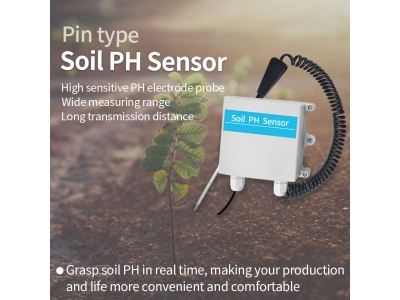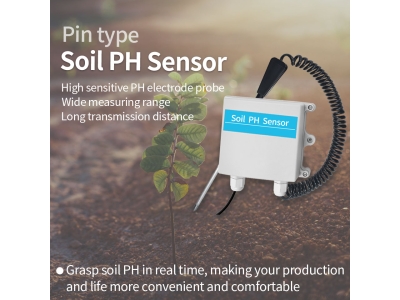Precision agriculture has witnessed significant advancements in recent years, thanks to the revolutionizing technology of soil sensors. These innovative devices have transformed the way farmers monitor and manage soil health, enabling them to make data-driven decisions for optimal crop production. Soil sensors provide real-time information about soil moisture, temperature, nutrient levels, and other critical parameters, allowing farmers to precisely tailor irrigation, fertilization, and other agronomic practices. In this article, we will explore the power of soil sensors in revolutionizing precision agriculture, their various types and applications, and the benefits they offer to farmers and the environment.
Types of Soil Sensors :
Soil sensors come in a variety of types, each designed to measure specific soil properties. Here are some common types of soil sensors used in precision agriculture:

a. Moisture Sensors: These sensors measure soil moisture content, providing valuable information for irrigation management. Capacitance-based sensors, tensiometers, and time-domain reflectometry (TDR) sensors are commonly used for measuring soil moisture.
b. Temperature Sensors: Temperature sensors are used to monitor soil temperature, an important parameter for crop growth and microbial activity. Thermocouples, thermistors, and infrared sensors are commonly employed to measure soil temperature.
c. Nutrient Sensors: Nutrient sensors measure the concentration of essential nutrients in the soil, such as nitrogen, phosphorus, and potassium. Ion-selective electrodes, optical sensors, and electrochemical sensors are commonly used to measure nutrient levels.
d. pH Sensors: pH sensors help in monitoring soil acidity or alkalinity. They provide information about soil pH, which is crucial for nutrient availability and crop productivity. Glass electrode and solid-state pH sensors are commonly used for soil pH measurements.
e. Electrical Conductivity (EC) Sensors: EC sensors determine the electrical conductivity of the soil, which is related to its salinity and nutrient content. These sensors help farmers optimize irrigation and fertilizer applications. EC sensors measure the ability of the soil to conduct an electrical current.
Applications of Soil Sensors in Precision Agriculture :
Soil sensors have a wide range of applications in precision agriculture. Let's explore some key areas where these sensors are revolutionizing farming practices:
a. Irrigation Management: Soil moisture sensors play a vital role in optimizing irrigation practices. By providing real-time data on soil moisture levels, farmers can precisely determine when and how much to irrigate. This helps in reducing water wastage, improving crop yield, and conserving water resources.
b. Nutrient Management: Soil nutrient sensors enable precise nutrient management, ensuring that crops receive optimal nutrition. By monitoring nutrient levels in the soil, farmers can adjust fertilizer application rates and timings, minimizing nutrient waste and environmental pollution.
c. Crop Health Monitoring: Soil sensors help in monitoring soil temperature, pH, and salinity levels, which directly impact crop health. By tracking these parameters, farmers can identify potential issues early on and take corrective measures to prevent crop diseases, nutrient deficiencies, or toxicity.
d. Yield Prediction: Soil sensors, along with other environmental sensors, contribute to yield prediction models. By integrating data from soil sensors with weather data and crop growth models, farmers can make accurate predictions about crop yields. This information aids in planning harvest and marketing strategies.
e. Environmental Impact Reduction: Soil sensors enable farmers to adopt precision application techniques for inputs like water and fertilizers. This precision reduces unnecessary resource usage, minimizing environmental impacts such as water pollution, soil degradation, and greenhouse gas emissions.
f. Variable Rate Application: Soil sensors allow for variable rate application of inputs, such as fertilizers and pesticides, based on the spatial variability of soil properties. By applying inputs only where necessary, farmers can optimize resource allocation and reduce input costs.
g. Data-Driven Decision Making: Soil sensor data, combined with other geospatial information, can be integrated into decision support systems. Farmers can utilize this data to make informed decisions about planting, irrigation, fertilization, and pest management strategies. It empowers them with actionable insights for efficient farm management.
Benefits of Soil Sensors in Precision Agriculture (approx. 300 words):
The adoption of soil sensors in precision agriculture offers numerous benefits to farmers, the environment, and society as a whole. Here are some key advantages:
a. Improved Crop Productivity: By accurately monitoring soil conditions, farmers can o






